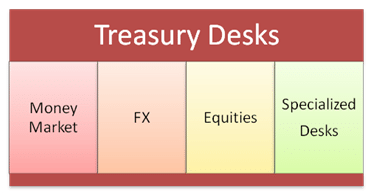The Bank Treasury Group is a specialized function that exists within banks and large corporations. The group is responsible for a number of activities such as buying and selling of foreign exchange currencies in a centralized fashion; borrowing to meet liquidity requirements as well as lending and placing excess cash to ensure all resources are usefully deployed; and depending on how the treasury group is structured, the function may also be responsible for managing and growing the investment portfolio including bonds, shares and any other financial securities.
The Bank Treasury functions are centralized because buying and selling currencies and borrowing and lending money requires a certain skill set and infrastructure and rather than distributing it across an organization it is more efficient to create a dedicated group to support it.
In this course, we aim to cover a selection of core bank treasury topics as well as certain application topics.
What are the prerequisites?
We begin by looking in detail at some concepts that will be referred to in the course. These include:
- Duration and Convexity
- Value at Risk
- Calculating forward prices and forward rates
- Building Maturity & Liquidity Profiles for Deposits and Advances
What topics are covered?
Once a review of the prerequisite topics has been covered you can now move on to the main course that covers an introduction to treasury operations and common terminology, liquidity management, calculating treasury profitability, derivative products, asset liability management tools, setting treasury risk limits, etc:
- Treasury operations
- Treasury Training Crash Course – cheat sheet
- Setting Limits
- ALM Crash Course
- Derivatives crash course
This course is followed by an online course that presents a framework for empowering client facing treasury teams to go out and cross sell high value, high margin trading concepts to clients. They do this by educating customers about their exposures and by presenting a range of available solutions from their treasury products portfolio that would help reduce the risk associated with these same exposures.
What are the additional topics I can read up on?
It is useful to learn from the mistakes made by others. The recent financial crisis of 2008, provides valuable insights into the liquidity risks financial institutions are exposed to and the measures that are taken to manage and mitigate those risks:
Price volatility in crude oil, gold, silver, cotton, sugarcane, wheat and cereals has created an unprecedented opportunity for corporate relationship managers to cross sell treasury products to their institutional, trading, manufacturing and high net worth customers. It is important to understand the interrelationship between these commodities. One useful tool that enables us to do this is:
There are a number of measures that risk or investment managers may need for evaluating the market risk inherent in their treasury portfolio or when making decisions on asset selection, portfolio allocation and portfolio optimization. We review the methodologies of some of these measures in the following topic:
We present a case study for a risk management framework for the Oil, Gas and Petrochemical industry focused on managing crude oil price volatility:
Premium Content:
- ALM Crash Course
- ALM – Crash Course – EXCEL Examples
- Building maturity and liquidity profiles for Deposits and Advances
- Calculating Value at Risk
- Calculating VaR – EXCEL
- Crude Oil Mispricing model
- Delta Hedging and Greeks – EXCEL
- Derivative products
- Derivatives terminology crash course
- Duration and Convexity Example
- Forward Prices and Forward Rates
- Forward Prices, Forward Rates and Forward Rate Agreements (FRAs)
- Portfolio Risk Metrics
- Relative Gold Price model
- Setting Counterparty limits
- Setting Limits for PSR
- Treasury Crash Course
- Treasury Crash Course – Package

